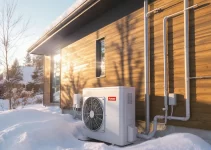Heating your home efficiently is no longer just about staying warm — it’s about maximizing your return on investment (ROI) while reducing environmental impact. With energy costs fluctuating and sustainability becoming a priority for many households, the heat pump vs furnace debate has never been more relevant.
In this guide, we’ll break down the differences between heat pumps and furnaces, explore efficiency metrics, analyze costs, and highlight real-world examples so you can make the smartest choice for your home.
Understanding the Basics
A heat pump moves heat from one place to another — from outside air (or ground) into your home during winter, and reverses the process in summer. A furnace, on the other hand, burns fuel (natural gas, oil, or propane) to create heat.
Heat pumps are the single biggest tool for U.S. households to cut carbon emissions and curb unhealthy air pollution.
— Canary Media
The efficiency difference is stark: a heat pump’s Coefficient of Performance (COP) is about 2.8, meaning it produces 2.8 units of heat per unit of electricity. Furnaces average a COP of 0.95 due to combustion losses.
| System | COP | Average Lifespan |
|---|---|---|
| Heat Pump | 2.8 | 12–15 years |
| Gas Furnace | 0.95 | 15–20 years |
As shown above, heat pumps excel in efficiency but may have slightly shorter lifespans.
Cost Comparison: Upfront vs Long-Term
Initial installation costs often influence decision-making:
- Heat Pump: $4,500–$8,000 installed
- Gas Furnace: $2,500–$6,000 installed
While furnaces are cheaper upfront, heat pumps typically deliver lower monthly energy bills, especially in moderate climates.
When factoring in government incentives like the U.S. Inflation Reduction Act (up to $2,000 in tax credits), the ROI calculation tips further in favor of heat pumps.
| System | Upfront Cost | Annual Savings | Payback Period |
|---|---|---|---|
| Heat Pump | $6,000 | $500 | 6–10 years |
| Gas Furnace | $4,000 | $200 | N/A |
In moderate climates, heat pumps can pay for themselves within a decade through energy savings alone.
Climate Considerations
In colder climates, traditional heat pumps may lose efficiency, making high-efficiency furnaces or cold-climate heat pumps more practical. Cold-climate models use advanced compressors and refrigerants to maintain performance down to -15°F.
For a deeper dive into this technology, see Cold Climate Heat Pumps: Efficiency, Tech & Savings.
Technically, heat pumps are more efficient in moderate temperatures because they move heat rather than generate it. But in colder regions, high-efficiency furnaces may still be more practical.
— PrimeGenius Inc.
Maintenance and Longevity
Furnaces require regular safety checks due to combustion and potential carbon monoxide risks. Heat pumps need coil cleaning and refrigerant checks but avoid combustion-related hazards.
Preventive maintenance can extend the lifespan of both systems. For homeowners, following a Heat Pump Maintenance & Troubleshooting Guide ensures optimal efficiency and fewer breakdowns.
ROI in Real-World Installations
Let’s consider a commercial retrofit case study: a Boston office replaced its aging furnace system with a modern VRF heat pump solution. The result? 38% lower energy use, reduced emissions, and a rapid ROI thanks to local utility incentives.
| Project Type | Energy Reduction | ROI Timeline |
|---|---|---|
| Boston Office Retrofit | 38% | 5 years |
This aligns with market trends: in 2024, manufacturers shipped 32% more heat pumps than gas furnaces, and sales in 2025 exceeded furnaces by 27%.
Market Trends and Future Outlook
Heading into 2025, several factors favor heat pumps:
- Government incentives lowering upfront costs
- Carbon pricing potentially increasing furnace operating costs
- Smart controls boosting efficiency
For emerging innovations, see 2025 Heat Pump Trends: Innovations in Energy Efficient Heating.
Implementation Strategies
If you’re considering a switch:
- Assess Climate — Moderate climates favor heat pumps, cold climates need specialized models.
- Calculate ROI — Factor in incentives, energy savings, and maintenance.
- Plan Installation — Work with certified installers familiar with local codes and incentive programs.
- Integrate Smart Controls — Optimize heating schedules and monitor energy use.
Conclusion
Heat pumps offer compelling ROI potential for homeowners seeking lower energy bills and reduced carbon footprints, especially in moderate climates. While furnaces still have a place in extreme cold, technological advances in cold-climate heat pumps are closing that gap.
Whether your priority is cost savings, sustainability, or comfort, understanding the heat pump vs furnace trade-offs ensures you invest wisely. With incentives, market trends, and efficiency gains all pointing toward heat pumps, now is the time to explore your options.
By analyzing your climate, energy costs, and available rebates, you can choose a heating solution that delivers both warmth and financial return for years to come.


